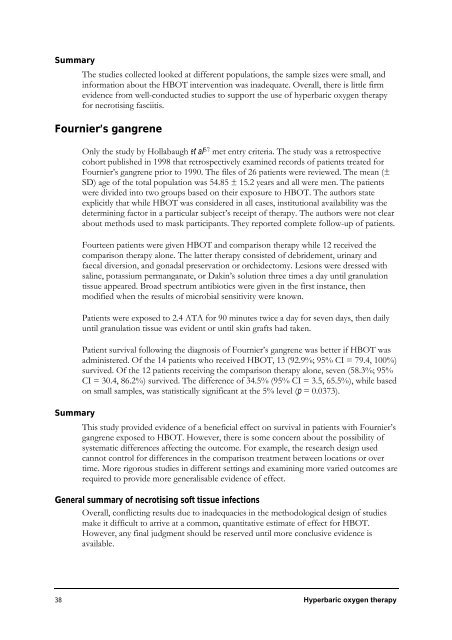Hyperbaric Oxygen Therapy - Hyperbaric Chamber Information ...
Hyperbaric Oxygen Therapy - Hyperbaric Chamber Information ...
Hyperbaric Oxygen Therapy - Hyperbaric Chamber Information ...
You also want an ePaper? Increase the reach of your titles
YUMPU automatically turns print PDFs into web optimized ePapers that Google loves.
Summary<br />
The studies collected looked at different populations, the sample sizes were small, and<br />
information about the HBOT intervention was inadequate. Overall, there is little firm<br />
evidence from well-conducted studies to support the use of hyperbaric oxygen therapy<br />
for necrotising fasciitis.<br />
Fournier’s gangrene<br />
Summary<br />
Only the study by Hollabaugh et al 57 met entry criteria. The study was a retrospective<br />
cohort published in 1998 that retrospectively examined records of patients treated for<br />
Fournier’s gangrene prior to 1990. The files of 26 patients were reviewed. The mean (±<br />
SD) age of the total population was 54.85 ± 15.2 years and all were men. The patients<br />
were divided into two groups based on their exposure to HBOT. The authors state<br />
explicitly that while HBOT was considered in all cases, institutional availability was the<br />
determining factor in a particular subject’s receipt of therapy. The authors were not clear<br />
about methods used to mask participants. They reported complete follow-up of patients.<br />
Fourteen patients were given HBOT and comparison therapy while 12 received the<br />
comparison therapy alone. The latter therapy consisted of debridement, urinary and<br />
faecal diversion, and gonadal preservation or orchidectomy. Lesions were dressed with<br />
saline, potassium permanganate, or Dakin’s solution three times a day until granulation<br />
tissue appeared. Broad spectrum antibiotics were given in the first instance, then<br />
modified when the results of microbial sensitivity were known.<br />
Patients were exposed to 2.4 ATA for 90 minutes twice a day for seven days, then daily<br />
until granulation tissue was evident or until skin grafts had taken.<br />
Patient survival following the diagnosis of Fournier’s gangrene was better if HBOT was<br />
administered. Of the 14 patients who received HBOT, 13 (92.9%; 95% CI = 79.4, 100%)<br />
survived. Of the 12 patients receiving the comparison therapy alone, seven (58.3%; 95%<br />
CI = 30.4, 86.2%) survived. The difference of 34.5% (95% CI = 3.5, 65.5%), while based<br />
on small samples, was statistically significant at the 5% level (p = 0.0373).<br />
This study provided evidence of a beneficial effect on survival in patients with Fournier’s<br />
gangrene exposed to HBOT. However, there is some concern about the possibility of<br />
systematic differences affecting the outcome. For example, the research design used<br />
cannot control for differences in the comparison treatment between locations or over<br />
time. More rigorous studies in different settings and examining more varied outcomes are<br />
required to provide more generalisable evidence of effect.<br />
General summary of necrotising soft tissue infections<br />
Overall, conflicting results due to inadequacies in the methodological design of studies<br />
make it difficult to arrive at a common, quantitative estimate of effect for HBOT.<br />
However, any final judgment should be reserved until more conclusive evidence is<br />
available.<br />
38 <strong>Hyperbaric</strong> oxygen therapy



